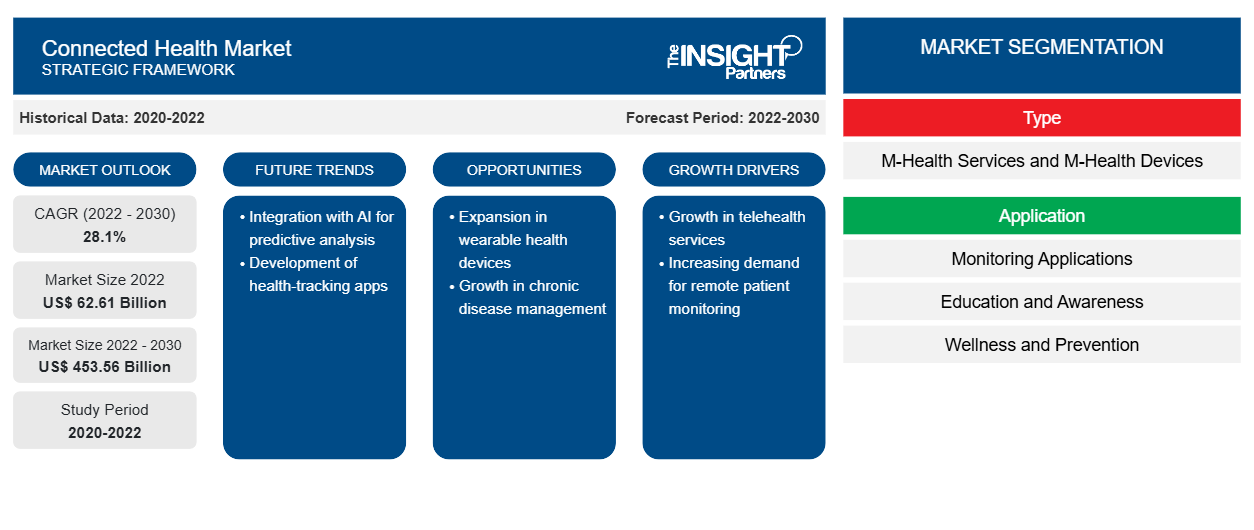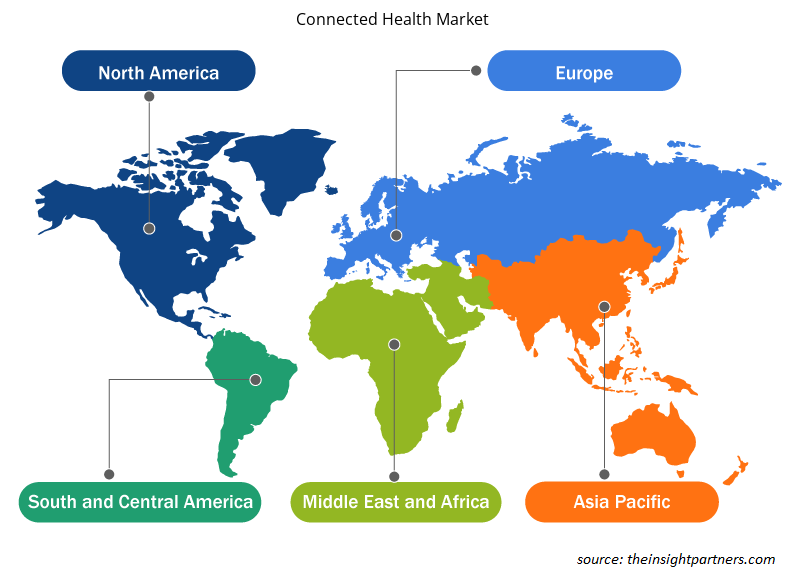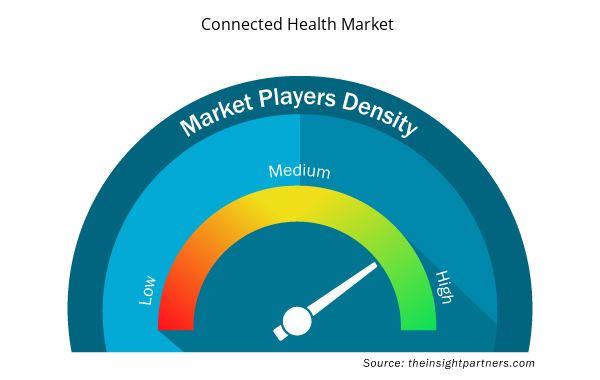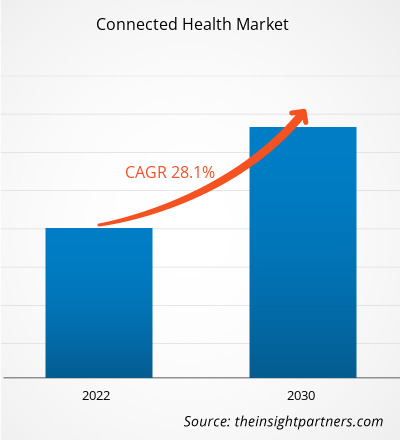[Research Report] The connected health market size was valued at US$ 62.61 billion in 2022 and is expected to reach US$ 453.56 billion by 2030. The market is estimated to register a CAGR of 28.1% from 2022 to 2030.
Market Insights and Analyst View:
Numerous healthcare organizations are finding new and more efficient ways to enhance the quality of treatment they provide due to the demand for value and an increasingly competitive environment. Enabling patient-provider connectivity "anytime and anywhere" is one way to make services more accessible and possibly less expensive. Remote diagnosis, treatment, monitoring, and communication are all possible with connected health (cHealth), an integrated care delivery system powered by technology. Factors such as the rising adoption of digital health and mAgeing program by WHO propel the connected health market growth.
Market Drivers:
Digital health contributes to making healthcare practices more manageable and easier by collecting health-related data or healthcare information and offering services to patients. Connected health technology is a tool that supports treatments, chronic disease management, and disease surveillance. The incidence of chronic diseases, including heart disease, diabetes, and cancer, is increasing as a result of changing lifestyles. For patients suffering from non-communicable diseases who need constant monitoring, digital health plays a key role in meeting such requirements. In many instances, the management of chronic diseases has changed as a result of remote monitoring via m-health technologies and data evaluation via digital tools and wearables. In addition to shifting the focus from acute and reactive care to proactive and preventative care, connected health has altered the way patients engage with healthcare providers and healthcare-based systems. Increased development and implementation of technologies that make digital healthcare affordable and convenient have aided in its adoption.
The increasing information technology leads to the rising adoption in the health sector is helping to grow connected health rapidly across the globe. Under mHealth, devices such as mobile phones, laptops, and tablets are playing a major role in increasing health coverage. Due to increasing mobile technology, governments and other organizations are turning to mobile devices to improve efficient productivity and also focus on coupling their power to use present health data in a timely manner. The hasty development of advanced technology allows the increased sharing of data information between electronic systems. The increasing health data security helps users with accurate data and provides decision-makers to improve the ability to make critical decisions. Thus, due to the easy access and wide variety of applications, a large number of people can use digital health, which is likely to boost the connected health market growth.
The adoption of the Internet of Medical Things (IoMT) is expected to bring new connected health markettrends in the coming years. However, many healthcare organizations introduce risks that result in personal health data breaches and do not provide guidelines for safeguarding electronic personal health information. Thus, the rising threats of using these services proportionally boost the health data security that restricts the connected health market.
Customize This Report To Suit Your Requirement
You will get customization on any report - free of charge - including parts of this report, or country-level analysis, Excel Data pack, as well as avail great offers and discounts for start-ups & universities
Connected Health Market: Strategic Insights

- Get Top Key Market Trends of this report.This FREE sample will include data analysis, ranging from market trends to estimates and forecasts.
Customize This Report To Suit Your Requirement
You will get customization on any report - free of charge - including parts of this report, or country-level analysis, Excel Data pack, as well as avail great offers and discounts for start-ups & universities
Connected Health Market: Strategic Insights

- Get Top Key Market Trends of this report.This FREE sample will include data analysis, ranging from market trends to estimates and forecasts.
Report Segmentation and Scope:
The “connected health market analysis” has been carried out by considering the following segments: type, application, and end user. By type, the market is bifurcated into m-health services and m-health devices. By application, the market is segmented into monitoring applications, diagnosis and treatment, healthcare management, wellness and prevention, and others. Based on end user, the market is categorized into hospitals and clinics, home monitoring, and others.
Segmental Analysis:
The connected health market, by type, is bifurcated into m-health services and m-health devices. The m-health services segment held a larger share of the market in 2022; however, the m-health devices segment is likely to register a higher CAGR in the connected health market during 2022–2030. Instead of having patients monitored internally at medical facilities, connected health puts more emphasis on remote data transfer and the provision of appropriate healthcare services at home. Aside from the ability to deliver healthcare remotely, the biggest breakthrough in connected health is the vast data that is made available. With the help of connected health services, doctors can make more informed decisions and provide proactive treatment that prioritizes patients’ needs.
By application, the connected health market is segmented into monitoring applications, diagnosis and treatment, healthcare management, wellness and prevention, and others. The monitoring applications segment held the largest share of the market in 2022; however, the diagnosis and treatment segment is likely to register the highest CAGR in the connected health market during 2022–2030. Remote monitoring systems integrated with the Internet of Things (IoT), digital sensors, and big data tools improve access to patients, which has opened new opportunities that focus on improving the delivery of healthcare services. The incorporation of these systems increased significantly during the COVID-19 crisis. Health remote monitoring systems (HRMS) offer various advantages, including reduced patient load at health centers and hospitals.
By end user, the connected health market is segmented into hospitals and clinics, home monitoring, and others. In 2022, the hospitals and clinics segment dominated the connected health market share. However, the home monitoring segment is expected to register the highest CAGR during 2022–2030. According to OAE Publishing Inc., in 2021, approximately half of all American hospitals have implemented some form of connected health for remote patient monitoring, and ~80% of European countries have included telemedicine services in their healthcare services.
Regional Analysis:
The scope of the connected health market report is primarily divided into North America (the US, Canada, and Mexico), Europe (Spain, the UK, Germany, France, Italy, and the Rest of Europe), Asia Pacific (South Korea, China, India, Japan, Australia, and the Rest of Asia Pacific), Middle East & Africa (South Africa, Saudi Arabia, the UAE, and the Rest of Middle East & Africa), and South & Central America (Brazil, Argentina, and the Rest of South & Central America).
In terms of revenue, in 2022, North America dominated the connected health market share. The market in Asia Pacific is anticipated to register the highest CAGR during 2022–2030. The market in Asia Pacific is growing due to the rising investments from international players in India and China, expanding bases of CRO services, advancing healthcare infrastructure, and improving government support. Moreover, Apollo introduced the Comprehensive Connected Care Programme in India in 2023. This program makes use of Apollo's cutting-edge Connected Care technology. Apollo's Comprehensive Connected Care services will be implemented nationwide, giving clinical teams and nursing staff access to a thorough, up-to-date patient overview at every stage of patient care, including home care, post-surgery care, in-patient care, and emergency and ambulance services.
Connected Health Market Regional Insights
Connected Health Market Regional Insights
The regional trends and factors influencing the Connected Health Market throughout the forecast period have been thoroughly explained by the analysts at Insight Partners. This section also discusses Connected Health Market segments and geography across North America, Europe, Asia Pacific, Middle East and Africa, and South and Central America.

- Get the Regional Specific Data for Connected Health Market
Connected Health Market Report Scope
| Report Attribute | Details |
|---|---|
| Market size in 2022 | US$ 62.61 Billion |
| Market Size by 2030 | US$ 453.56 Billion |
| Global CAGR (2022 - 2030) | 28.1% |
| Historical Data | 2020-2022 |
| Forecast period | 2022-2030 |
| Segments Covered |
By Type
|
| Regions and Countries Covered | North America
|
| Market leaders and key company profiles |
Connected Health Market Players Density: Understanding Its Impact on Business Dynamics
The Connected Health Market market is growing rapidly, driven by increasing end-user demand due to factors such as evolving consumer preferences, technological advancements, and greater awareness of the product's benefits. As demand rises, businesses are expanding their offerings, innovating to meet consumer needs, and capitalizing on emerging trends, which further fuels market growth.
Market players density refers to the distribution of firms or companies operating within a particular market or industry. It indicates how many competitors (market players) are present in a given market space relative to its size or total market value.
Major Companies operating in the Connected Health Market are:
- Athena Health
- AgaMatrix
- AirStrip
- AliveCor Inc
- Allscripts Healthcare, LLC
Disclaimer: The companies listed above are not ranked in any particular order.

- Get the Connected Health Market top key players overview
Competitive Landscape and Key Companies:
The connected health market report is focused on prominent players in the market such as Athena Health, AgaMatrix, AirStrip, AliveCor Inc, Allscripts Healthcare LLC, Apple Inc, NXGN Management LLC, Cerner Corporation, Cognizant, and Honeywell International Inc. The connected health market forecast can help stakeholders plan their growth strategies. These companies focus on new technologies, upgrading existing products, and market expansions to meet the growing consumer demand worldwide.
- In December 2023, GE HealthCare and AirStrip entered into a joint commercialization agreement. GE HealthCare became the exclusive distributor of AirStrip Cardiology and Patient Monitoring solutions in the US, offering data visualization technology to healthcare systems.
- In January 2023, BioIntelliSense partnered with care.ai to incorporate BioIntelliSense’s high-frequency vital sign trending data and algorithmic-based alerting into care.ai’s Ambient Monitoring workflows. The partnership relates the complementary capabilities of these transformative technologies to improve patient satisfaction, optimize clinical operations, and directly address the key challenges faced by the overburdened healthcare workforce.
- Historical Analysis (2 Years), Base Year, Forecast (7 Years) with CAGR
- PEST and SWOT Analysis
- Market Size Value / Volume - Global, Regional, Country
- Industry and Competitive Landscape
- Excel Dataset


- Health Economics and Outcome Research (HEOR) Services Market
- Airline Ancillary Services Market
- Truck Refrigeration Market
- Aircraft MRO Market
- Single-Use Negative Pressure Wound Therapy Devices Market
- Blood Collection Devices Market
- Bathroom Vanities Market
- Animal Genetics Market
- Enzymatic DNA Synthesis Market
- GNSS Chip Market

Report Coverage
Revenue forecast, Company Analysis, Industry landscape, Growth factors, and Trends

Segment Covered
Type, Application, and End User

Regional Scope
North America, Europe, Asia Pacific, Middle East & Africa, South & Central America

Country Scope
This text is related
to country scope.
Frequently Asked Questions
The connected health market, based on type, is bifurcated into m-health services and m-health devices. The m-health services segment held a larger share of the market in 2022; however, the m-health devices segment is likely to register a higher CAGR in the connected health market during 2022–2030.
US holds the largest market share in connected health market. The US held a significant share in the connected health market as the country has strong technological developments. The FDA regulates most of the mHealth apps in the US that perform patient-specific analysis and/or patient-specific treatment or diagnosis recommendations to confirm that any application that might lead to health risks is moderated. The rising use of smartphones and the prevalence of mobile technology use both lifestyle and clinical applications, which propels the market growth.
A technique of managing healthcare that uses technology to deliver services or treat medical issues is usually referred to as "connected health." Mobile personal emergency response systems (mPERS), telemedicine, decentralised clinical trials (DCTs), and remote patient monitoring (RPM) are a few prominent instances of linked health. Consumer-grade wearables and wireless implanted medical devices are examples of connected health devices. Insulin pumps, blood pressure monitors, glucose monitors, pulse oximeters, personal ECG monitors, and other devices are frequently connected medical devices.
The connected health market, based on end user, segmented into hospitals and clinics, home monitoring, and others. In 2022, the hospitals and clinics segment dominated the connected health market share. However, the home monitoring segment is expected to register the highest CAGR during 2022–2030.
Asia Pacific is expected to be the fastest growing region in the connected health market. The connected health market in Asia Pacific is growing due to the rising investments from international players in India and China, expanding bases of CRO services, advancing healthcare infrastructure, and improving government support. Moreover, Apollo introduced the Comprehensive Connected Care Programme in India in 2023.
The connected health market majorly consists of the players such as Athena Health, AgaMatrix AirStrip, AliveCor Inc, Allscripts Healthcare LLC, NXGN Management LLC, Cerner Corporation, Cognizant, Honeywell International Inc among others.
The connected health market, based on application, is segmented segmented into monitoring applications, diagnosis and treatment, healthcare management, wellness and prevention, and others. The monitoring applications segment held the largest share of the market in 2022; however, the diagnosis and treatment segment is likely to register the highest CAGR in the connected health market during 2022–2030.
The factors that are driving growth of the market are rising adoption of digital health and mAgeing program by WHO.
Trends and growth analysis reports related to Technology, Media and Telecommunications : READ MORE..
The List of Companies - Connected Health Market
- Athena Health
- AgaMatrix
- AirStrip
- AliveCor Inc
- Allscripts Healthcare, LLC
- Apple Inc
- NXGN Management, LLC
- Cerner Corporation
- Cognizant
- Honeywell International Inc

 Get Free Sample For
Get Free Sample For